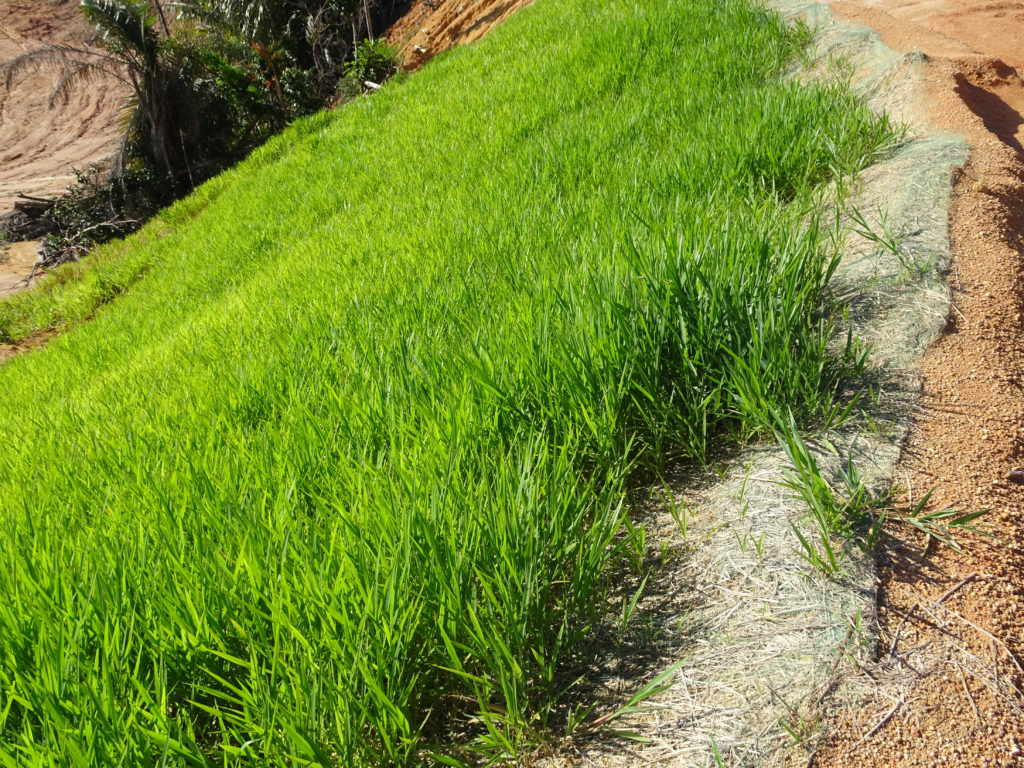Even though land erosion (the wearing away of earth from the flow of stormwater runoff) is a process that can occur naturally over time, it is something that can especially be a problem with new land development both during and after construction. However, there are certain things that can help reduce the risk of erosion issues.
The following are eight ways to prevent erosion problems with a new land development project.
1) Install erosion control matting.
2) Install riprap.
3) Minimize flow velocity.
4) Minimize runoff rate.
5) Spread out discharge.
6) Avoid excessive land slope lengths.
7) Establish vegetation.
8) Avoid proposed steep grading.
1. Install Erosion Control Matting
One of the most common ways to prevent erosion with the construction of a new land development project is the installation of erosion control matting. Erosion control matting, also referred to as erosion control blankets, is a special kind of material that is designed to hold bare earth in place until permanent vegetation can be established after a certain amount of time has passed after the installation of the matting.
Erosion control matting is usually used in areas of proposed grading with slopes of 3 feet (horizontal distance) to 1 foot (vertical distance) or greater. It is also used in proposed grass swales (channels) which often times have side slopes of 3 to 1 or greater.
Advertisement
2. Install Riprap
Riprap is a prepared quantity of rock used to reduce the velocity of stormwater flow by simply breaking up the flow of water as it runs over and through the rocks.
Riprap can be installed in the form of a riprap pad (also referred to as a riprap apron) at the outlet of a storm sewer pipe or a culvert pipe. It can also be installed in the form of a general erosion control covering on a steep slope area (such as on the downstream side of an emergency spillway of a detention basin).
The size of the individual rocks in riprap can range from a couple of inches to over a foot in width.
3. Minimize Flow Velocity
Since the amount of potential erosion increases with an increase in the velocity (the speed that is usually expressed in units of feet per second) of stormwater runoff, reducing the design velocity of runoff at the outlets of proposed storm sewer pipes and driveway culverts can reduce the amount of potential erosion after the construction of a new project.
The design velocity of a storm sewer pipe or culvert can be minimized during the engineering design phase of a project through minimizing the slope of the pipe or culvert. The velocity can also be minimized by the civil engineer designing the project by maximizing the size of the pipe or culvert.
Related: Storm Drainage System Design (A Guide for the Non-Professional)
4. Minimize Runoff Rate
A large stormwater runoff rate (the rate of volume of runoff that is usually expressed in units of cubic feet per second) can result in a large velocity of runoff to a runoff discharge area. Therefore, potential erosion to a certain area can be avoided if the volume of runoff to that area can be minimized.
The volume of runoff to a certain area can be minimized through the construction of diversion inlets, pipes, or channels that would direct runoff to somewhere else on the site and reduce the original drainage area.
5. Spread Out Discharge
Another way to prevent erosion from concentrated stormwater discharges is to direct water into a level spreader trench which is filled with stone. The concentrated water would fill this trench and spill over the top at a uniform elevation. The flow would be spread out over a certain distance at a small depth that would help to avoid erosion.
A level spreader is often used at the outlet of a stormwater management basin.
6. Avoid Excessive Land Slope Lengths
Something else that is a cause of land erosion is a long distance that stormwater runoff would have to flow on a steep proposed graded area with a slope of 3 to 1 or greater. A long flow path distance gives the runoff more time for the amount of flow to build up and start wearing away at the ground below.
For areas of proposed steep grading, keeping the proposed length of flow along these areas to a minimum would help to reduce the potential for erosion in these areas.
7. Establish Vegetation
Bare earth is easily susceptible to erosion and steps should be taken as soon as practical to establish vegetation on new graded areas.
Proposed vegetation could be in the form of grass or proposed landscaping that includes trees and shrubs. Once this vegetation grows, it both provides a ground covering for stormwater runoff to flow over and helps to hold the soil below in place to keep it stabilized.
A typical land development plan should usually include steps in the sequence of construction regarding the stabilization of new graded areas through the installation of grass seed soon after the grading of these areas.
Advertisement
8. Avoid Proposed Steep Grading
Although there might be times when steep grading is required for a project to work out properly, minimizing proposed steep grading in general during the design of a new plan will help to reduce the risk of excessive land slope lengths. Also, the design of smaller grading slopes will result in smaller runoff velocities which means there would be less erosion potential.
Planning Now Can Prevent Erosion Later
Erosion can be a major issue both during and after the construction of a land development project. However, proper planning on the part of the civil engineer designing the project with the consideration of at least some of the above methods for erosion prevention will help to minimize erosion problems that could occur later.
Related: 6 Common Methods to Control Sediment



